WD TV Live Plus: Western Digital's Latest Media Player Reviewed
by Cameron Butterfield on July 29, 2010 1:00 AM EST- Posted in
- Home Theater
- Media Streamer
- WD
- WD TV Live Plus
Disassembling the WD TV Plus reveals a passive heatsink design, which is preferred in this class of device since there is no fan noise to distract from the viewing experience. The heatsink found within the unit is comparable to the size of a standard northbridge heatsink found on modern motherboards. The device is well built, the plastic is thick and durable, and the chassis has very little wasted space, which helps it keep a very small footprint. The device also uses metal foil tape to connect the tray to the metal portion of the frame of the device which may also help to distribute some of the heat. Once the heatsink is removed we can see the Sigma Secure Media Processor in the center of the mainboard. Also of note, we see that the unit uses Hynix DDR memory chips, and a RTL8201EL Realtek NIC controller. The Realtek RTL8201EL is a single-chip/single-port Fast Ethernet PHYceiver that is capable of operating at 10/100Mbps, full/half duplex, auto-negotiation and power down modes.
The WD TV Live Plus uses the same clamshell style design that many of their HDD products such as the MyBook line.
Within the plastic casing, a metal tray and cover exist to hold the mainboard
The heatsink and mainboard
The back end of the mainboard.
The processor and memory chips uncovered.
The WD TV Live Plus has a Sigma Media Processor, a chip designed for IPTV, cable, thin clients and media players. This processor architecture is built for low power operation and boasts advanced content protection, digital rights management and a wide list of media format capabilities.
The WDTV Live Plus is almost identical to the WDTV Live, the only apparent difference being the change in processor model number. The Plus version utilizes a Sigma SMP8654 media processor, while the previous WD TV Live version utilizes the SMP8655. Although the SMP8655 has a higher model number, the additional digit actually signifies that it is the Non-Macrovision version. Utilizing the SMP8654 Sigma processor rather than the SMP8655 previously used in the WD TV Live HD is essential for doing the two things that the Plus version of WDTV Live is capable of doing in addition to the features it's predecessor already supported, namely Netflix streaming. We reason that WD had to release the WD TV Live Plus with a new processor because there is no content protection available otherwise for the composite output. This output is analog in nature, and Macrovision is meant for analog output protection. On HDMI, HDCP is more than enough. It is likely that the older WDTV Live HD could have supported Netflix with just a firmware update, but would not have been able to protect the content over composite signals.
Here is a layout of the Sigma Processor architecture followed by a list of features and specifications:
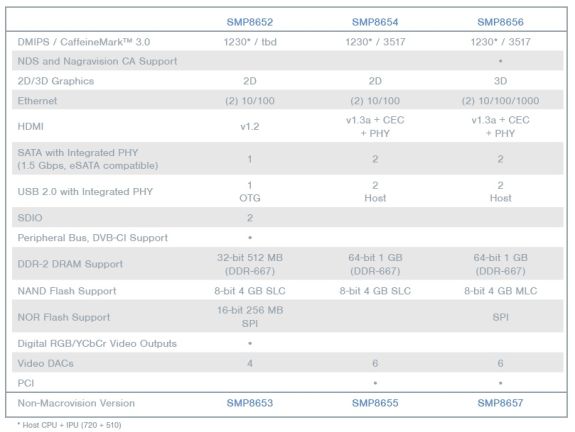
The SMP8654 media processor has 1GB of built in DDR-667, and has interface support beyond the capabilities that it is utilized in WDs implementation. One of those features that would have possibly added value to a device like the WD TV Plus is the SATA IO support. This capability could have possibly been utilized to provide an eSATA interface, allowing further support for Western Digitals HDD products such as the eSATA myDVR expander and other eSATA devices supplied by Western Digital.


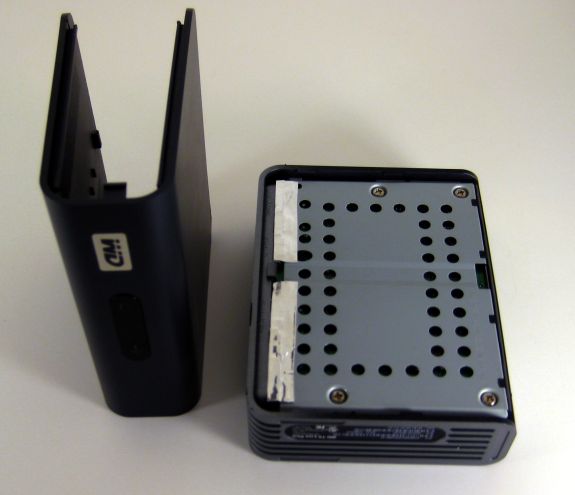
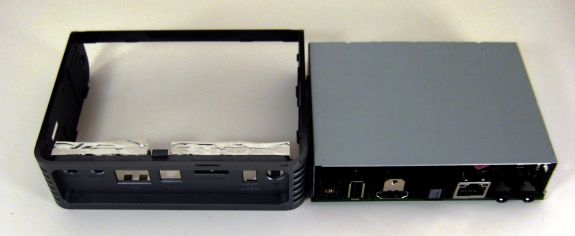
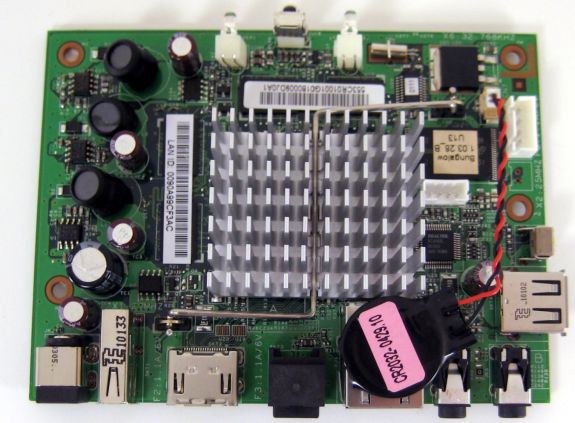
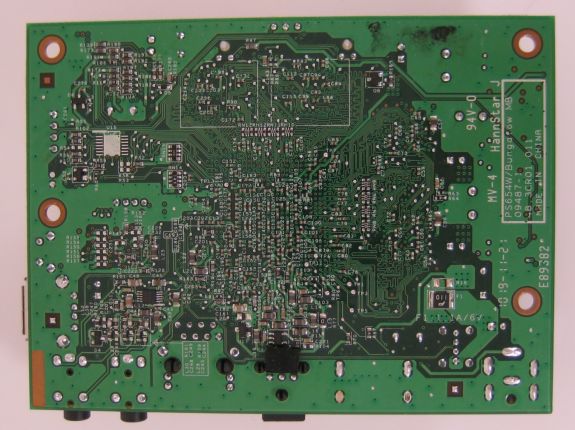
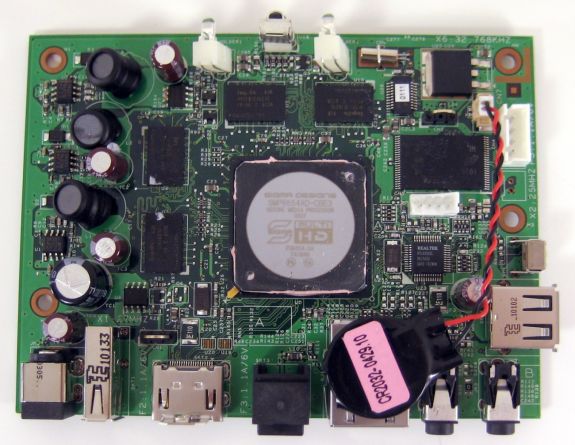
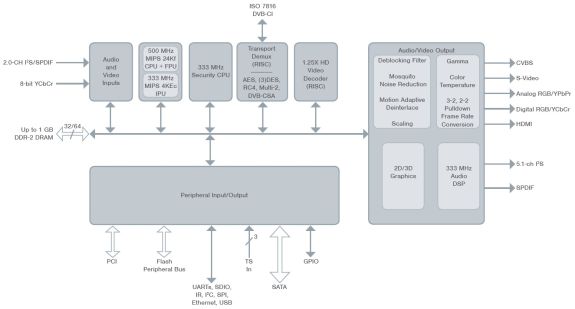








81 Comments
View All Comments
adamsteinberg - Saturday, July 31, 2010 - link
I'd like to see which files you actually used -- it'd be good to have as a reference for the rest of us.ganeshts - Sunday, August 1, 2010 - link
Most of the streams in the test suite are available with a search on Google (such as the infamous bird scene clip from Planet Earth / NMT DVD5 Test Disc contents) . Some of them are copyrighted, and can't be made publicly available.Instead of releasing files selectively, we think it would be better to avoid releasing the any part of the suite to the public. That said, media streamer vendors can and do get access to the files if they find that their units are unable to playback a particular stream in our review process.
jmunjr - Monday, August 2, 2010 - link
Did they improve on the WD Live's lousy network support? There was no cataloging of media via the network, only on loccal drives connected to USB. What's the point of network support if finding media requires manually navigating the network shares? STUPID.Also playing any music off the network is pointless as well as you have to manually navigate and it is impossible to even shuffle music effectively without putting it all into one folder with no subfolders. STUPID.
SlyNine - Monday, August 2, 2010 - link
As I said in my post. I agree and this is important for people trying to serve multiple rooms. Or people that are not computer illiterate.Jmunjr, I would try out twonky. It makes things alot easier.
jmunjr - Tuesday, August 3, 2010 - link
Sorry if I missed that part of the article.Twonky looks promising. Thanks.
SlyNine - Monday, August 2, 2010 - link
I bought the WDLive for the living room. I bought Twonky to make it easier to use. The most important thing is ease of use if I'm going to deploy them threw out the house. I don't want people bugging me about how to use it.Really it all comes down to being able to map network shares and have the player build a library. So the next person only has a simple menu, Video, Music.
So if you could take the to talk about ease of use, I'd really appreciate that.
Also any media server recommendations would be great.
ProDigit - Monday, August 2, 2010 - link
Hah!The thing I had hoped to see was a built in TV decoder, and it does not even have it!
Why even bother with the 'TV' in the product's name, when the only thing it can do is connect to LCD or Plasma screens via HDMI?
I mean, if it really was a TV media box, the least it should have had was a TV and radio tuner (both digital and analog) to make it somewhat interesting!
So far it seems nothing more than a harddrive with a low quality graphics card attached to it...
I'm happy they invent things like this, but that's not fully what the average customer needs!
Especially not when LCD's are becoming cheap, and you can buy a 28" LCD screen for under 300, and connect it to a TV tuner AND a pc at the same time.
In other words as a media player it succeeds, but not to replace a home theater!
People living in studio's would really want this TV decoder function added to the HD playback ability of this device, in ONE device.
One thing that's bothering me the most is the amount of remotes that are on an average livingroom table. One for the TV, one for the VCR, one for the DVD, one for the blueray, and one for the sattelite or cable signal decoder.
They could have made all this in one device, leaving you with one USB port for the blueray drive to watch blueray or DVD videos, one remote for the LCD and one for this device.
Modelworks - Sunday, August 8, 2010 - link
The WD boxes and most others use a chipset originally designed for DVR , IPTV, and set top boxes for cable and satellite service. When they were designed they were designed with specific codecs and industry standards. Do not expect them to play every combination of video that exist because the ones that will not play on the box are not following the specification. One thing that a pc allows users to do is update codecs. Often those updates are not to fix problems in the codec but to allow the codec to play content that has been encoded using options that are not part of the specification. People like to try pushing codecs and often that leads to files not playing except for those that have the same version codec as the encoder.If you like to play with codec settings and use files that do then a pc is the only option. If you stick to established specifications then the sigma based players are as good as anything.
De-interlacing is not a strong part of the sigma chipsets and little attention is given to it in the sdk. Part of the reason for this is it was designed with playing back content that is already de-interlaced. Only Mpeg2 is given some real attention and the file has to be in the DVD specified format .
If WMAPRO is important for you , you can visit this site to get the custom firmware that adds support for it.
http://b-rad.cc/1249/wdlxtv-live-0-4-2-1/#more-124...
DTS/Dolby support varies with players. Just depends on if they wanted to play the licensing fees or not . All the current sigma chipset can decode the format fine.
IcetomLT - Wednesday, August 18, 2010 - link
Very good review!. I think now Anandtech developed best testing for media players!Just one ask - is it possible to include HQV PAL 1.4a DVD tests (for SD signal). Because, now your HQV test shows only player's performance for NTSC type signal in HD resolution and doesn't show how good upscaling engine is used in player and if it supports PAL cadences.
kojak40 - Tuesday, April 15, 2014 - link
I have a question. Can I see the attached storage connected the the we live TV box on my computer. I want to be able to send files to the hard drive from my computer and or android phone. If I can't do that it's a deal breaker for me.